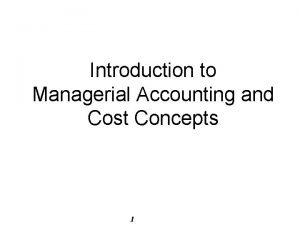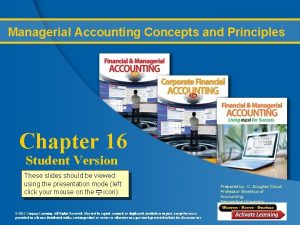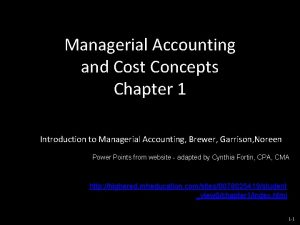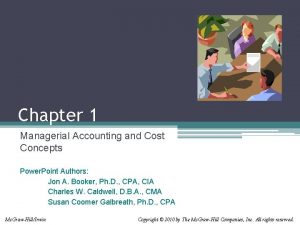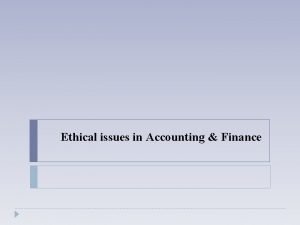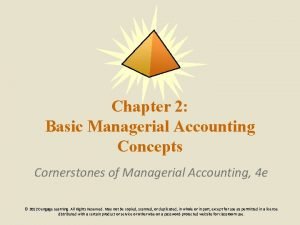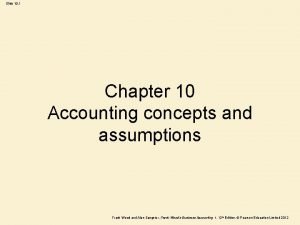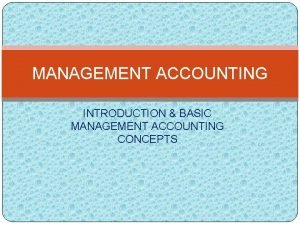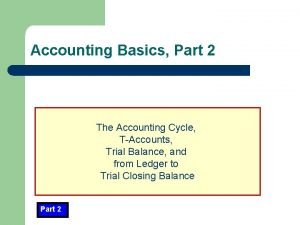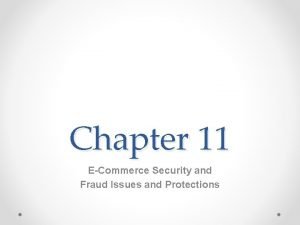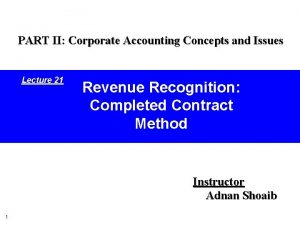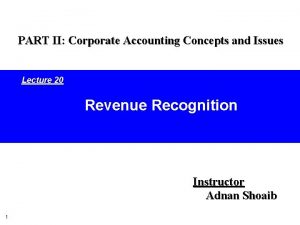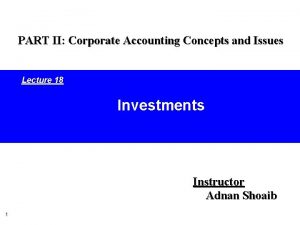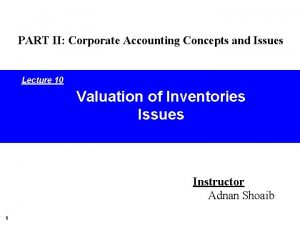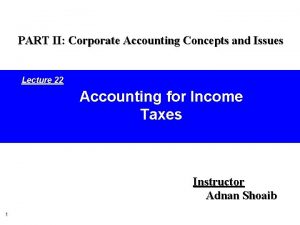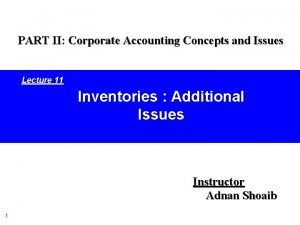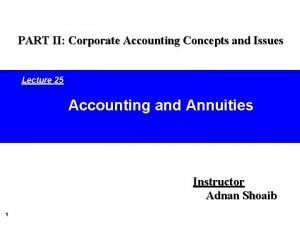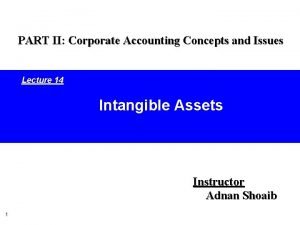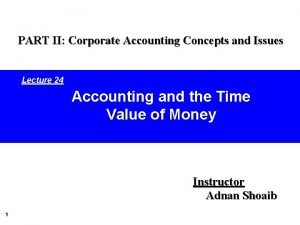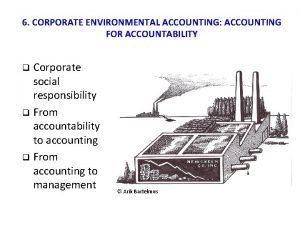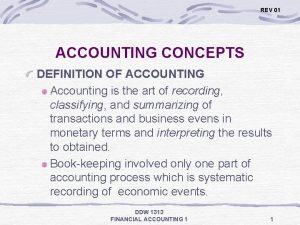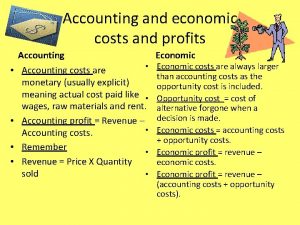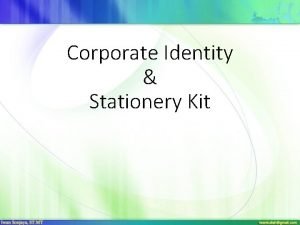PART II Corporate Accounting Concepts and Issues Lecture






























































- Slides: 62

PART II: Corporate Accounting Concepts and Issues Lecture 09 Practical Issues in Cash and Receivable: Disposition and Recognitions Instructor Adnan Shoaib 1

Learning Objectives 2 1. Explain accounting issues related to recognition and valuation of notes receivable. 2. Explain the fair value option. 3. Explain accounting issues related to disposition of accounts and notes receivable. 4. Describe how to report and analyze receivables.

Cash and Receivables Cash What is cash? Reporting cash Summary of cash-related items Accounts Receivable Notes Receivable Recognition of accounts receivable Recognition of notes receivable Valuation of accounts receivable Valuation of notes receivable Special Issues Fair value option Disposition of accounts and notes receivable Presentation and analysis 3

Recognition of Notes Receivable Supported by a formal promissory note. 4 u A negotiable instrument. u Maker signs in favor of a Payee. u Interest-bearing (has a stated rate of interest) OR u Zero-interest-bearing (interest included in face amount). LO 1 Explain accounting issues related to recognition of notes receivable.

Recognition of Notes Receivable Generally originate from: 5 u Customers who need to extend payment period of an outstanding receivable. u High-risk or new customers. u Loans to employees and subsidiaries. u Sales of property, plant, and equipment. u Lending transactions (the majority of notes). LO 1 Explain accounting issues related to recognition of notes receivable.

Recognition of Notes Receivable 6 Short-Term Long-Term Record at Face Value, less allowance Record at Present Value of cash expected to be collected Interest Rates Note Issued at Stated rate = Market rate Face Value Stated rate > Market rate Premium Stated rate < Market rate Discount LO 1 Explain accounting issues related to recognition of notes receivable.

Note Issued at Face Value Illustration: Bigelow Corp. lends Scandinavian Imports $10, 000 in exchange for a $10, 000, three-year note bearing interest at 10 percent annually. The market rate of interest for a note of similar risk is also 10 percent. How does Bigelow record the receipt of the note? i = 10% $10, 000 Principal 0 7 $1, 000 1 2 n=3 1, 000 Interest 3 4 LO 1 Explain accounting issues related to recognition of notes receivable.

Note Issued at Face Value PV of Interest $1, 000 x Interest Received 8 2. 48685 Factor = $2, 487 Present Value LO 1 Explain accounting issues related to recognition of notes receivable.

Note Issued at Face Value PV of Principal $10, 000 Principal 9 x . 75132 Factor = $7, 513 Present Value LO 1 Explain accounting issues related to recognition of notes receivable.

Note Issued at Face Value Summary Present value of interest $ 2, 487 Present value of principal 7, 513 Note current market value $10, 000 Notes receivable 10, 000 Cash Interest revenue 10 10, 000 1, 000 LO 1 Explain accounting issues related to recognition of notes receivable.

Zero-Interest-Bearing Note Illustration: Jeremiah Company receives a three-year, $10, 000 zero-interest-bearing note. The market rate of interest for a note of similar risk is 9 percent. How does Jeremiah record the receipt of the note? i = 9% $10, 000 Principal 0 11 $0 $0 1 2 n=3 $0 Interest 3 4 LO 1 Explain accounting issues related to recognition of notes receivable.

Zero-Interest-Bearing Note PV of Principal $10, 000 Principal 12 x . 77218 Factor = $7, 721. 80 Present Value LO 1 Explain accounting issues related to recognition of notes receivable.

Zero-Interest-Bearing Note Illustration 7 -12 13 LO 1 Explain accounting issues related to recognition of notes receivable.

Zero-Interest-Bearing Note Journal Entries for Zero-Interest-Bearing note Present value of Principal 14 $7, 721. 80 LO 1 Explain accounting issues related to recognition of notes receivable.

Interest-Bearing Note Illustration: Morgan Corp. makes a loan to Marie Co. and receives in exchange a three-year, $10, 000 note bearing interest at 10 percent annually. The market rate of interest for a note of similar risk is 12 percent. How does Morgan record the receipt of the note? i = 12% $10, 000 Principal 0 15 $1, 000 1 2 n=3 1, 000 Interest 3 4 LO 1 Explain accounting issues related to recognition of notes receivable.

Interest-Bearing Note PV of Interest $1, 000 x Interest Received 16 2. 40183 Factor = $2, 402 Present Value LO 1 Explain accounting issues related to recognition of notes receivable.

Interest-Bearing Note PV of Principal $10, 000 Principal 17 x . 71178 Factor = $7, 118 Present Value LO 1 Explain accounting issues related to recognition of notes receivable.

Interest-Bearing Note Illustration: How does Morgan record the receipt of the note? Illustration 7 -14 Notes Receivable Discount on Notes Receivable Cash 18 10, 000 480 9, 520 LO 1 Explain accounting issues related to recognition of notes receivable.

Interest-Bearing Note Illustration 7 -15 19 LO 1 Explain accounting issues related to recognition of notes receivable.

Interest-Bearing Note Journal Entries for Interest-Bearing Note Cash Discount on notes receivable Interest revenue 20 1, 000 142 1, 142 LO 1 Explain accounting issues related to recognition of notes receivable.

U. S. GAAP vs. IFRS In general, IFRS and U. S. GAAP are very similar with respect to accounts receivable and notes receivable. Differences are highlighted below. l l l 21 U. S. GAAP allows a “fair value option” for accounting for receivables. U. S. GAAP does not allow receivables to be accounted for as “available for sale” investments. U. S. GAAP requires more disaggregation of accounts and notes receivable in the balance sheet or notes. l l IFRS restricts the circumstances in which a “fair value option” for accounting for receivables is allowed. In the years between 2010 and 2012, companies may account for receivables as “available for sale” investments if the approach is elected initially. After January 1, 2013, this treatment is no longer allowed.

Recognition of Notes Receivable Notes Received for Property, Goods, or Services In a bargained transaction entered into at arm’s length, the stated interest rate is presumed to be fair unless: 1. No interest rate is stated, or 2. Stated interest rate is unreasonable, or 3. Face amount of the note is materially different from the current cash sales price. 22 LO 1 Explain accounting issues related to recognition of notes receivable.

Recognition of Notes Receivable Illustration: Oasis Development Co. sold a corner lot to Rusty Pelican as a restaurant site. Oasis accepted in exchange a fiveyear note having a maturity value of $35, 247 and no stated interest rate. The land originally cost Oasis $14, 000. At the date of sale the land had a fair market value of $20, 000. Oasis uses the fair market value of the land, $20, 000, as the present value of the note. Oasis therefore records the sale as: ($35, 247 - $20, 000) = $15, 247 Notes Receivable Discount on Notes Receivable Land Gain on Sale of Land 23 35, 247 14, 000 6, 000 LO 1 Explain accounting issues related to recognition of notes receivable.

Valuation of Notes Receivable u Short-Term reported at Net Realizable Value (same as accounting for accounts receivable). u Long-Term - FASB requires companies disclose not only their cost but also their fair value in the notes to the financial statements. ► 24 Fair Value Option. Companies have the option to use fair value as the basis of measurement in the financial statements. LO 2 Explain the fair value option.

Valuation of Notes Receivable Illustration (recording fair value option): Assume that Escobar Company has notes receivable that have a fair value of $810, 000 and a carrying amount of $620, 000. Escobar decides on December 31, 2012, to use the fair value option for these receivables. This is the first valuation of these recently acquired receivables. At December 31, 2012, Escobar makes an adjusting entry to record the increase in value of Notes Receivable and to record the unrealized holding gain, as follows. Notes Receivable 190, 000 Unrealized Holding Gain or Loss—Income 25 190, 000 LO 2 Explain the fair value option.

Disposition of Accounts and Notes Receivable Owner may transfer accounts or notes receivables to another company for cash. Reasons: u Competition. u Sell receivables because money is tight. u Billing / collection are time-consuming and costly. Transfer accomplished by: 1. Secured borrowing 2. Sale of receivables 26 LO 3 Explain accounting issues related to disposition of accounts and notes receivable.

Factoring Arrangements 2. Accounts Receivable SUPPLIER (Transferor) RETAILER 1. Merchandise 3. h le ab iv e ec as C 5. C s. R as h t un o cc A 4. FACTOR (Transferee) 27 A factor is a financial institution that buys receivables for cash, handles the billing and collection of the receivables and charges a fee for the service.

Disposition of Accounts and Notes Receivable Secured Borrowing Illustration: March 1, 2012, Howat Mills, Inc. provides (assigns) $700, 000 of its accounts receivable to Citizens Bank as collateral for a $500, 000 note. Howat Mills continues to collect the accounts receivable; the account debtors are notified of the arrangement. Citizens Bank assesses a finance charge of 1 percent of the accounts receivable and interest on the note of 12 percent. Howat Mills makes monthly payments to the bank for all cash it collects on the receivables. 28 LO 3 Explain accounting issues related to disposition of accounts and notes receivable.

Secured Borrowing - Illustration 7 -16 29 LO 8

Secured Borrowing - Exercise E 7 -13: On April 1, 2012, Prince Company assigns $500, 000 of its accounts receivable to the Third National Bank as collateral for a $300, 000 loan due July 1, 2012. The assignment agreement calls for Prince Company to continue to collect the receivables. Third National Bank assesses a finance charge of 2% of the accounts receivable, and interest on the loan is 10% (a realistic rate of interest for a note of this type). Instructions: a) Prepare the April 1, 2012, journal entry for Prince Company. b) Prepare the journal entry for Prince’s collection of $350, 000 of the accounts receivable during the period from April 1, 2012, through June 30, 2012. c) 30 On July 1, 2012, Prince paid Third National all that was due from the loan it secured on April 1, 2012. LO 3 Explain accounting issues related to disposition of accounts and notes receivable.

Secured Borrowing - Exercise 7 -13 continued 31 LO 8

Sales of Receivables Factors are finance companies or banks that buy receivables from businesses for a fee. Illustration 7 -17 32 LO 3 Explain accounting issues related to disposition of accounts and notes receivable.

Sales of Receivables Sale Without Recourse u Purchaser assumes risk of collection u Transfer is outright sale of receivable u Seller records loss on sale u Seller use Due from Factor (receivable) account to cover discounts, returns, and allowances Sale With Recourse 33 u Seller guarantees payment to purchaser u Financial components approach used to record transfer LO 3 Explain accounting issues related to disposition of accounts and notes receivable.

Sales of Receivables Illustration: Crest Textiles, Inc. factors $500, 000 of accounts receivable with Commercial Factors, Inc. , on a without recourse basis. Commercial Factors assesses a finance charge of 3 percent of the amount of accounts receivable and retains an amount equal to 5 percent of the accounts receivable (for probable adjustments). Crest Textiles and Commercial Factors make the following journal entries for the receivables transferred without recourse. Illustration 7 -18 34 LO 3 Explain accounting issues related to disposition of accounts and notes receivable.

Sales of Receivables Illustration: Assume Crest Textiles sold the receivables on a with recourse basis. Crest Textiles determines that this recourse obligation has a fair value of $6, 000. To determine the loss on the sale of the receivables, Crest Textiles computes the net proceeds from the sale as follows. Illustration 7 -19 Net Proceeds Computation Illustration 7 -20 Loss on Sale Computation 35 LO 8

Sales of Receivables Illustration: Prepare the journal entries for both Crest Textiles and Commercial Factors for the receivables sold with recourse. Crest Textiles, Inc. Commercial Factors, Inc. 36 Cash Due from Factor Loss on Sale of Receivables Accounts (Notes) Receivable Recourse Liability 460, 000 25, 000 21, 000 Accounts Receivable Due to Crest Textiles Financing Revenue Cash 500, 000 6, 000 25, 000 15, 000 460, 000 LO 3 Explain accounting issues related to disposition of accounts and notes receivable.

Transfers of Notes Receivable On December 31, Stridewell accepted a nine-month 10 percent note for $200, 000 from a customer. Three months later on March 31, Stridewell discounted the note at its local bank. The bank’s discount rate is 12 percent. Before preparing the journal entry to record the discounting, Stridewell must record the accrued interest on the note from December 31 until March 31. Interest receivable Interest revenue 37 $200, 000 × 10% × 3/12 5, 000

Transfers of Notes Receivable Cash Loss on sale of note receivable Notes receivable Interest receivable $205, 000 - $202, 100 38 202, 100 2, 900 200, 000 5, 000

Deciding Whether to Account for a Transfer as a Sale or a Secured Borrowing 39

U. S. GAAP vs. IFRS The U. S. GAAP and the IFRS approaches often lead to similar accounting treatment for transfers of receivables. l 40 U. S. GAAP focuses on whether control of assets has shifted from the transferor to the transferee. l IFRS requires a more complex decision process. The company has to have transferred the rights to receive the cash flows from the receivable, and then considers whether the company has transferred “substantially all of the risks and rewards of ownership, ” as well as whether the company has transferred

Secured Borrowing versus Sale Illustration 7 -22 The FASB concluded that a sale occurs only if the seller surrenders control of the receivables to the buyer. Three conditions must be met. 41 LO 3 Explain accounting issues related to disposition of accounts and notes receivable.

Presentation and Analysis Presentation of Receivables 1. Segregate the different types of receivables that a company possesses, if material. 2. Appropriately offset the valuation accounts against the proper receivable accounts. 3. Determine that receivables classified in the current assets section will be converted into cash within the year or the operating cycle, whichever is longer. 4. Disclose any loss contingencies that exist on the receivables. 5. Disclose any receivables designated or pledged as collateral. 6. Disclose the nature of credit risk inherent in the receivables. 42 LO 4 Describe how to report and analyze receivables.

Presentation and Analysis of Receivables Illustration 7 -24 This Ratio used to: 43 u Assess the liquidity of the receivables. u Measure the number of times, on average, a company collects receivables during the period. LO 4 Describe how to report and analyze receivables.

CASH CONTROLS Management faces two problems in accounting for cash transactions: 1. Establish proper controls to prevent any unauthorized transactions by officers or employees. 2. Provide information necessary to properly manage cash on hand cash transactions. 44 LO 5 Explain common techniques employed to control cash.

CASH CONTROLS Using Bank Accounts To obtain desired control objectives, a company can vary the number and location of banks and the types of accounts. 45 u General checking account u Collection float. u Lockbox accounts u Imprest bank accounts LO 5 Explain common techniques employed to control cash.

CASH CONTROLS The Imprest Petty Cash System To pay small amounts for miscellaneous expenses. Steps: 1. Record $300 transfer of funds to petty cash: Petty Cash 300 2. The petty cash custodian obtains signed receipts from each individual to whom he or she pays cash. 46 LO 5 Explain common techniques employed to control cash.

CASH CONTROLS The Imprest Petty Cash System Steps: 3. Custodian receives a company check to replenish the fund. Office Supplies Expense 42 Postage Expense 53 Entertainment Expense 76 Cash Over and Short Cash 47 2 173 LO 5 Explain common techniques employed to control cash.

CASH CONTROLS The Imprest Petty Cash System Steps: 4. If the company decides that the amount of cash in the petty cash fund is excessive by $50, it lowers the fund balance as follows. Cash 50 Petty cash 48 50 LO 5 Explain common techniques employed to control cash.

CASH CONTROLS Physical Protection of Cash Balances Company should 49 u Minimize the cash on hand. u Only have on hand petty cash and current day’s receipts. u Keep funds in a vault, safe, or locked cash drawer. u Transmit each day’s receipts to the bank as soon as practicable. u Periodically prove (reconcile) the balance shown in the general ledger. LO 5 Explain common techniques employed to control cash.

CASH CONTROLS Reconciliation of Bank Balances Schedule explaining any differences between the bank’s and the company’s records of cash. Reconciling Items: 1. Deposits in transit. 2. Outstanding checks. 3. Bank charges and credits. Time Lags 4. Bank or Depositor errors. 50 LO 5 Explain common techniques employed to control cash.

CASH CONTROLS Reconciliation of Bank Balances 51 Illustration 7 A-1 Bank Reconciliation Form and Content LO 5 Explain common techniques employed to control cash.

CASH CONTROLS 52 LO 10

CASH CONTROLS Illustration 7 A-2 53

CASH CONTROLS Illustration: Journalize the adjusting entries at November 30 on the books of Nugget Mining Company. Nov. 30 Cash 542 Office expense Accounts receivable 54 18 220 Accounts payable 180 Interest revenue 600 LO 5 Explain common techniques employed to control cash.

CASH CONTROLS Review Question The reconciling item in a bank reconciliation that will result in an adjusting entry by the depositor is: a. outstanding checks. b. deposit in transit. c. a bank error. d. bank service charges. 55 LO 5 Explain common techniques employed to control cash.

IMPAIRMENT OF RECEIVABLES Companies evaluate their receivables to determine their ultimate collectibility. Allowance method is appropriate when: u probable that an asset has been impaired and u amount of the loss can be reasonably estimated. Long-term receivables such as loans that are identified as impaired, companies perform an additional impairment evaluation. 56 LO 6 Describe the accounting for a loan impairment.

IMPAIRMENT OF RECEIVABLES Impairment Measurement and Reporting Impairment loss is calculated as the difference between 57 u the investment in the loan (generally the principal plus accrued interest) and u the expected future cash flows discounted at the loan’s historical effective interest rate. LO 6 Describe the accounting for a loan impairment.

IMPAIRMENT OF RECEIVABLES Illustration: At December 31, 2011, Ogden Bank recorded an investment of $100, 000 in a loan to Carl King. The loan has an historical effective-interest rate of 10 percent, the principal is due in full at maturity in three years, and interest is due annually. The loan officer performs a review of the loan’s expected future cash flow and utilizes the present value method for measuring the required impairment loss. Illustration 7 B-1 58 LO 7 Describe the accounting for a loan impairment.

IMPAIRMENT OF RECEIVABLES Illustration: Computation of Impairment Loss Illustration 7 B-2 Recording Impairment Losses Bad Debt Expense 12, 437 Allowance for Doubtful Accounts 59 12, 437 LO 7 Describe the accounting for a loan impairment.

RELEVANT FACTS 60 u The accounting and reporting related to cash is essentially the same under both IFRS and GAAP. In addition, the definition used for cash equivalents is the same. One difference is that, in general, IFRS classifies bank overdrafts as cash. u Like GAAP, cash and receivables are generally reported in the current assets section of the balance sheet under IFRS. However, companies may report cash and receivables as the last items in current assets under IFRS.

RELEVANT FACTS 61 u The fair value option is similar under GAAP and IFRS but not identical. The international standard related to the fair value option is subject to certain qualifying criteria not in the U. S. standard. u IFRS and GAAP differ in the criteria used to account for transfers of receivables. IFRS is a combination of an approach focused on risks and rewards and loss of control. GAAP uses loss of control as the primary criterion. In addition, IFRS generally permits partial transfers; GAAP does not.

End of Lecture 09 62
 1. part one—analyzing accounting concepts and procedures
1. part one—analyzing accounting concepts and procedures Corporate finance objectives
Corporate finance objectives 01:640:244 lecture notes - lecture 15: plat, idah, farad
01:640:244 lecture notes - lecture 15: plat, idah, farad Corporate governance lecture
Corporate governance lecture Basic concepts of financial accounting
Basic concepts of financial accounting Accounting convention
Accounting convention Managerial accounting and cost concepts
Managerial accounting and cost concepts Modifying principles of accounting
Modifying principles of accounting Managerial accounting concepts and principles
Managerial accounting concepts and principles Relevant range managerial accounting
Relevant range managerial accounting Chapter 1 managerial accounting and cost concepts
Chapter 1 managerial accounting and cost concepts Ethical issues in accounting and finance
Ethical issues in accounting and finance Finance and accounting issues in strategy implementation
Finance and accounting issues in strategy implementation Public sector definition
Public sector definition What is firm underwriting
What is firm underwriting Accounting responsibility
Accounting responsibility Moh accounting
Moh accounting Chapter 4 accounting study guide
Chapter 4 accounting study guide 10 accounting concepts
10 accounting concepts Management accounting concepts
Management accounting concepts Concept of cost in accounting
Concept of cost in accounting Core concepts of accounting information systems
Core concepts of accounting information systems Basic management accounting concepts
Basic management accounting concepts Arun and balu are partners in a firm
Arun and balu are partners in a firm 3 basic accounting principles
3 basic accounting principles Accounting cost concept
Accounting cost concept Chapter 4 accrual accounting concepts
Chapter 4 accrual accounting concepts Ethical issues in accounting
Ethical issues in accounting Social issues in accounting
Social issues in accounting Financial accounting and accounting standards chapter 1
Financial accounting and accounting standards chapter 1 Addition symbol
Addition symbol Unit ratio definition
Unit ratio definition Brainpop ratios
Brainpop ratios What is technical description
What is technical description Function of front bar
Function of front bar The phase of the moon you see depends on ______.
The phase of the moon you see depends on ______. Part to part variation
Part to part variation Accounting basics part 2
Accounting basics part 2 Computerized accounting systems
Computerized accounting systems Going on concern principle
Going on concern principle Four model approach
Four model approach Typical process description tools include
Typical process description tools include Legal ethical and societal issues
Legal ethical and societal issues Ecommerce security issues
Ecommerce security issues Legal and ethical issues in information security
Legal and ethical issues in information security Magnetism
Magnetism Power system dynamics and stability lecture notes
Power system dynamics and stability lecture notes Microbial physiology and metabolism lecture notes
Microbial physiology and metabolism lecture notes Limits fits and tolerances
Limits fits and tolerances Cloud computing lecture
Cloud computing lecture 50f7 tolerance
50f7 tolerance Financial intermediaries ppt
Financial intermediaries ppt Indirect finance
Indirect finance Extempore and lecture
Extempore and lecture Utilities and energy lecture
Utilities and energy lecture Catherine belsey books
Catherine belsey books Mechatronics notes
Mechatronics notes Vct monitoring foetal
Vct monitoring foetal Lecture on love courtship and marriage
Lecture on love courtship and marriage Power system dynamics and stability lecture notes
Power system dynamics and stability lecture notes Project planning and management lecture notes ppt
Project planning and management lecture notes ppt Adductor (subsartorial) canal
Adductor (subsartorial) canal Business strategy vs corporate strategy
Business strategy vs corporate strategy






